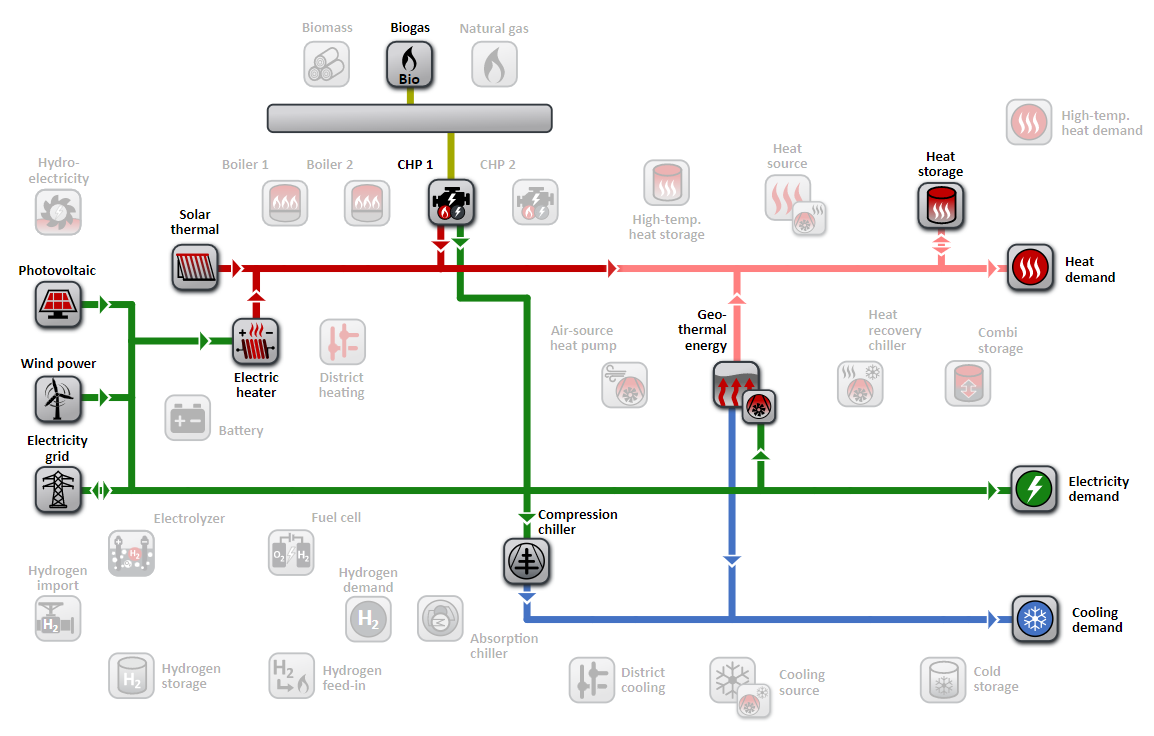nPro: Software tool for the calculation and design of heat networks
The planning and design of heat networks varies in complexity depending on the network type and network typology. Especially for innovative low-temperature concepts with decentralized heat feeds (prosumers), network planning can be challenging.
Planning and calculating heat networks
The planning of heat networks consists of multiple steps. Firstly, the heat network route must be determined. The network route is planned in such a way that the total length of the heating network is minimized as far as possible in order to reduce investment costs. For conventional heat networks, pipe diameter dimensioning is then carried out according to the usual design methods, taking diversity factors into account. For meshed networks as well as cold district heating networks (5GDHC networks) with decentralized heat feed points, however, the selection of suitable pipe diameters is substantially more complex: Here, not only a single design point can be considered, but the year-round operating behavior must be analyzed. For the planning and economic assessment of heat sources, temperature levels, available power, local distances and temporal fluctuations play a role. Most heat networks also require an energy center (also called energy hub), in which heat generation units and buffer storage tanks are installed. The optimal dimensioning of different heating and cooling technologies in interaction with renewable energies is important and can also only be optimized by means of a year-round operational analysis. The topic of measurement and control technology is also becoming increasingly important: Which sensors are needed in which subsystem? Which control logic is implemented in the system? Where will measurement data be collected, evaluated and visualized?
In summary, the following points are relevant for the planning of heat networks:
- Route planning: Where does the heat network run?
- Dimensioning: Which pipe diameters must be provided?
- Planning of heat sources: Which local heat sources can be used?
- Planning of the energy center: Which heat generation units must be installed in addition to the heat sources?
- Measurement and control concept: Which measurement and control technology will be installed?
- Profitability analysis: Under which economic boundary conditions is the heat network economical?

Steps for the heat network simulation
To plan a heating network, a simulation model of the network and the generators is created. In this way, the operation of the district can be analyzed at an early planning stage (digital twin). This helps to identify optimization possibilities at an early stage and to adjust the planning at an early stage. Several work steps are necessary for a hydraulic and thermal network simulation:
- Analysis of energy demands: Generation of demand profiles for one or more design years
- Creation of a digital twin of the planned heating network (if possible from GIS data)
- Carrying out the dynamic simulations with suitable simulation software
- Analysis of network operation: Pressure ratios, heat losses, etc.
- Sensitivity analysis: Influence of different pipe diameters, insulation thicknesses, etc.
How does the nPro tool help with heat network planning?
The nPro tool covers all essential steps of district planning: Demand profiles with an hourly resolution can be created for space heating, domestic hot water, space cooling, process cooling, plug loads (electricity) and e-mobility. Demand profiles of individual buildings can be aggregated to a total demand for heating, cooling and electricity at the energy center, taking into account the building energy system and a simulation of the heat network. Thermal and hydraulic losses as well as simultaneity factors can be taken into account. For network dimensioning, pipe diameters of the individual heat network sections can be determined and optimized semi-automatically. In addition to heat networks, nPro also covers special cold district heating networks (5GDHC networks). In a second module, hybrid energy systems can be designed, for example for the energy center of a heating network. In addition to conventional heat generating technologies such as CHP units and boilers, heat pumps, renewable energies (photovoltaics, wind power and solar thermal energy) and hydrogen solutions can also be calculated. The design is divided into 2 parts: In the first calculation step, the plants are dimensioned on the basis of a techno-economic optimization model. In a second step, the dimensioned energy system can be simulated for an entire year. The result of the full-year simulation is then presented in terms of system efficiency and cost-effectiveness, and the operation of each plant is visualized.
Overall, the nPro tool covers the steps of load profile generation, heat network calculation as well as design optimization and is thus ideally suited for the comparison of different energy concepts in the early planning phase. The tool documentation provides an overview of the entire functional scope of the tool.
This might also interest you
nPro software
Plan your energy system with nPro!

 English
English
 Deutsch
Deutsch


